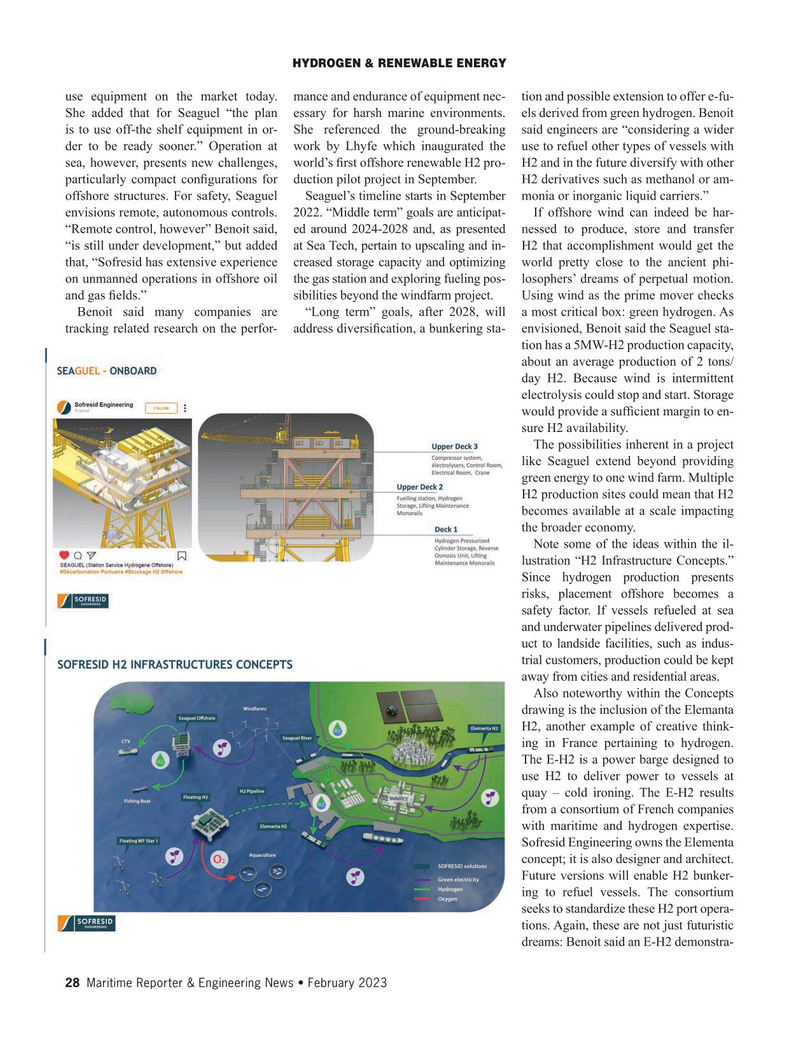
Page 28: of Maritime Reporter Magazine (February 2023)
Government Shipbuilding
Read this page in Pdf, Flash or Html5 edition of February 2023 Maritime Reporter Magazine
HYDROGEN & RENEWABLE ENERGY use equipment on the market today. mance and endurance of equipment nec- tion and possible extension to offer e-fu-
She added that for Seaguel “the plan essary for harsh marine environments. els derived from green hydrogen. Benoit is to use off-the shelf equipment in or- She referenced the ground-breaking said engineers are “considering a wider der to be ready sooner.” Operation at work by Lhyfe which inaugurated the use to refuel other types of vessels with sea, however, presents new challenges, world’s ? rst offshore renewable H2 pro- H2 and in the future diversify with other particularly compact con? gurations for duction pilot project in September. H2 derivatives such as methanol or am- offshore structures. For safety, Seaguel Seaguel’s timeline starts in September monia or inorganic liquid carriers.” envisions remote, autonomous controls. 2022. “Middle term” goals are anticipat- If offshore wind can indeed be har- “Remote control, however” Benoit said, ed around 2024-2028 and, as presented nessed to produce, store and transfer “is still under development,” but added at Sea Tech, pertain to upscaling and in- H2 that accomplishment would get the that, “Sofresid has extensive experience creased storage capacity and optimizing world pretty close to the ancient phi- on unmanned operations in offshore oil the gas station and exploring fueling pos- losophers’ dreams of perpetual motion. and gas ? elds.” sibilities beyond the windfarm project. Using wind as the prime mover checks
Benoit said many companies are “Long term” goals, after 2028, will a most critical box: green hydrogen. As tracking related research on the perfor- address diversi? cation, a bunkering sta- envisioned, Benoit said the Seaguel sta- tion has a 5MW-H2 production capacity, about an average production of 2 tons/ day H2. Because wind is intermittent electrolysis could stop and start. Storage would provide a suf? cient margin to en- sure H2 availability.
The possibilities inherent in a project like Seaguel extend beyond providing green energy to one wind farm. Multiple
H2 production sites could mean that H2 becomes available at a scale impacting the broader economy.
Note some of the ideas within the il- lustration “H2 Infrastructure Concepts.”
Since hydrogen production presents risks, placement offshore becomes a safety factor. If vessels refueled at sea and underwater pipelines delivered prod- uct to landside facilities, such as indus- trial customers, production could be kept away from cities and residential areas.
Also noteworthy within the Concepts drawing is the inclusion of the Elemanta
H2, another example of creative think- ing in France pertaining to hydrogen.
The E-H2 is a power barge designed to use H2 to deliver power to vessels at quay – cold ironing. The E-H2 results from a consortium of French companies with maritime and hydrogen expertise.
Sofresid Engineering owns the Elementa concept; it is also designer and architect.
Future versions will enable H2 bunker- ing to refuel vessels. The consortium seeks to standardize these H2 port opera- tions. Again, these are not just futuristic dreams: Benoit said an E-H2 demonstra- 28 Maritime Reporter & Engineering News • February 2023
MR #2 (18-33).indd 28 2/1/2023 3:41:34 PM

 27
27

 29
29
